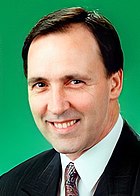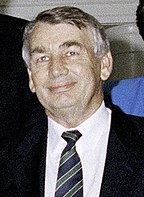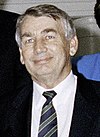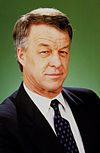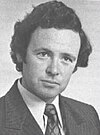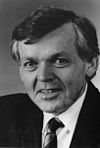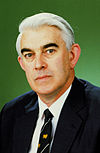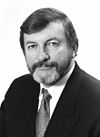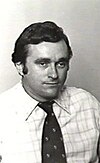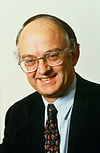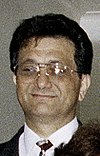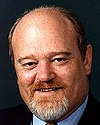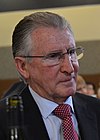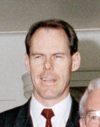
Robert James Lee Hawke was an Australian politician and trade unionist who served as the 23rd prime minister of Australia from 1983 to 1991. He held office as the leader of the Australian Labor Party (ALP), having previously served as the president of the Australian Council of Trade Unions from 1969 to 1980 and president of the Labor Party national executive from 1973 to 1978.

Paul John Keating is an Australian former politician who served as the 24th prime minister of Australia from 1991 to 1996, holding office as the leader of the Labor Party (ALP). He previously served as treasurer under Prime Minister Bob Hawke from 1983 to 1991 and as the seventh deputy prime minister from 1990 to 1991.

Simon Findlay Crean was an Australian politician and trade unionist. He was the leader of the Australian Labor Party (ALP) and leader of the opposition from 2001 to 2003. He represented the seat of Hotham in the House of Representatives from 1990 to 2013 and was a cabinet minister in the Hawke, Keating, Rudd and Gillard governments.
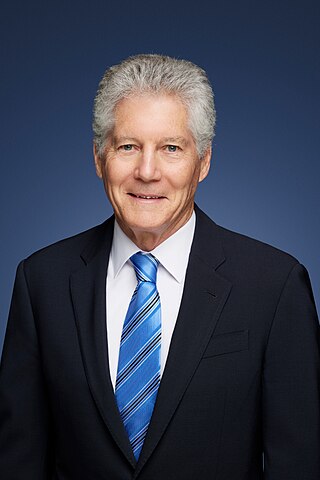
Stephen Francis Smith is an Australian former politician and diplomat serving as the 26th and current high commissioner of Australia to the United Kingdom since 2023. A member of the Australian Labor Party (ALP), he was the federal member of Parliament (MP) for the division of Perth from 1993 to 2013, serving in the Rudd and Gillard governments as minister for Foreign Affairs from 2007 to 2010, minister for Trade in 2010 and minister for Defence from 2010 to 2013.

The 1993 Australian federal election was held to determine the members of the 37th Parliament of Australia. It was held on 13 March 1993. All 147 seats of the Australian House of Representatives and 40 seats of the 76-seat Australian Senate were up for election. The incumbent government of the centre-left Australian Labor Party led by Paul Keating, the Prime Minister of Australia, was re-elected to a fifth term, defeating the centre-right Liberal/National Coalition led by Opposition Leader John Hewson of the Liberal Party of Australia, and coalition partner Tim Fischer of the National Party of Australia. This was the first, and to date only, time the Labor Party won a fifth consecutive election.

The first Hawke ministry (Labor) was the 54th ministry of the Government of Australia. It was led by the country's 23rd Prime Minister, Bob Hawke. The first Hawke ministry succeeded the Fourth Fraser ministry, which dissolved on 11 March 1983 following the federal election that took place on 5 March which saw Labor defeat Malcolm Fraser's Liberal–National Coalition. The ministry was replaced by the second Hawke ministry on 13 December 1984 following the 1984 federal election.

The fourth Hawke ministry (Labor) was the 57th ministry of the Government of Australia. It was led by the country's 23rd Prime Minister, Bob Hawke. The fourth Hawke ministry succeeded the third Hawke ministry, which dissolved on 4 April 1990 following the federal election that took place on 24 March. The ministry was replaced by the first Keating ministry on 20 December 1991 following the resignation of Hawke as Prime Minister after a successful leadership challenge by Paul Keating.

Ralph Willis AO is an Australian former politician who served as a Cabinet Minister during the entirety of the Hawke-Keating government from 1983 to 1996, most notably as Treasurer of Australia from 1993 to 1996 and briefly in 1991. He also served as Minister for Industrial Relations, Minister for Transport and Communications and Minister for Finance. He represented the Victorian seat of Gellibrand in the House of Representatives from 1972 to 1998.

John Sydney "Joe" DawkinsAO is an Australian former politician who was Treasurer in the Keating Labor government from December 1991 to December 1993. He is notable for his reforms of tertiary education as Minister for Employment, Education and Training, his period as Treasurer when he attempted to increase taxes in order to balance the budget and his abrupt exit from politics.

John Charles Kerin was an Australian economist and Labor Party politician who served in the House of Representatives from 1972 to 1975 and again from 1978 to 1993. He held a number of senior ministerial roles in both the Hawke and Keating governments, including six months as Treasurer of Australia and eight years as Minister for Primary Industries and Energy, holding the latter role for the longest period in Australian history.
Peter Staples is an Australian former politician for the Australian Labor Party. He was first elected to Parliament in 1983 as the Member for Diamond Valley, defeating Liberal incumbent Neil Brown. When Diamond Valley was abolished in 1984, Staples transferred to the newly created Jagajaga, essentially the more Labor-friendly western half of his old electorate. The eastern portion became Menzies and was taken by Brown.
Ross Vincent Free is a former Australian politician who served as a Labor member of the Australian House of Representatives representing the seat of Macquarie from 1980 until 1984, then Lindsay from 1984 until 1996. He served as a minister from 1990 until 1996 in both the Hawke and Keating ministries.

Benjamin Charles HumphreysAM was an Australian politician. He was a member of the Australian Labor Party (ALP) and served in the House of Representatives from 1977 to 1996, representing the Division of Griffith in Queensland. He was Minister for Veterans' Affairs in the Hawke and Keating Governments from 1987 to 1993.

The Hawke–Keating government is an all-encompassing term to describe the duration of the Hawke government and the Keating government, which together spanned from 11 March 1983 to 11 March 1996. Both governments were formed by the Australian Labor Party, and were led from 1983 to 1991 by Bob Hawke as Prime Minister, and from 1991 to 1996 by Paul Keating as Prime Minister, with Keating serving as Treasurer throughout the Hawke government. During the Hawke–Keating government, the Labor Party won five successive federal elections, its most electorally successful period to date; the 13-year uninterrupted period of government also remains the Labor Party's longest spell in power at the federal level. This period in Australia’s political history is also referred to as the Hawke-Keating era.

The Hawke government was the federal executive government of Australia led by Prime Minister Bob Hawke of the Australian Labor Party (ALP) from 1983 to 1991. The government followed the Liberal-National Coalition Fraser government and was succeeded by another Labor administration, the Keating government, led by Paul Keating after an internal party leadership challenge in 1991. Keating was Treasurer through much of Hawke's term as prime minister and the period is sometimes termed the Hawke-Keating government.
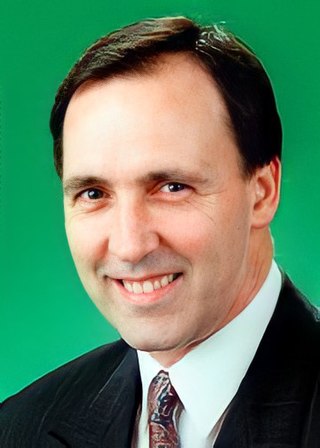
The Keating government was the federal executive government of Australia led by Prime Minister Paul Keating of the Australian Labor Party from 1991 to 1996. The government followed on from the Hawke government after Paul Keating replaced Bob Hawke as Labor leader in an internal party leadership challenge in 1991. Together, these two governments are often collectively described as the Hawke-Keating government. The Keating government was defeated in the 1996 federal election and was succeeded by John Howard's Coalition government.

A leadership spill of the Australian Labor Party (ALP), the party of government in the Parliament of Australia, was held on 19 December 1991, the second spill in a year. Backbencher and former treasurer Paul Keating defeated Prime Minister Bob Hawke, who had led Labor for eight and a half years.

A leadership spill in the Australian Labor Party, the party of government in the Parliament of Australia, was held on 3 June 1991. It was the first of two ballots that year with Prime Minister Bob Hawke surviving the ballot against Treasurer Paul Keating, who then went to the backbench.
The early 1990s recession saw a period of economic downturn affect much of the world in the late 1980s and early 1990s. The economy of Australia suffered its worst recession since the Great Depression.
The Shadow Ministry of John Hewson was the opposition Coalition shadow ministry of Australia from 11 April 1990 to 23 May 1994, opposing the Australian Labor Party's Hawke–Keating government.
